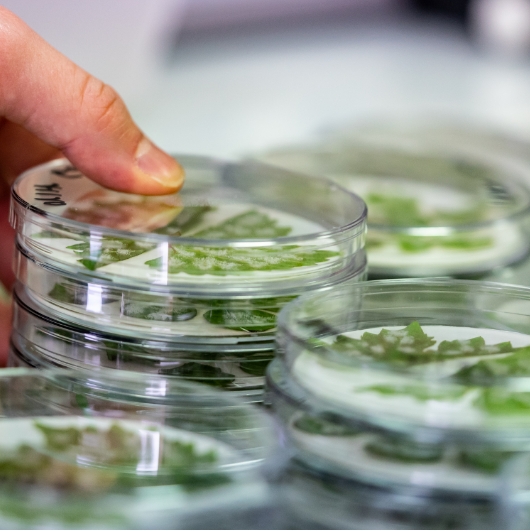How do we test the efficacy of phytosanitary products?
Fungal (mold) control and monitoring to defend against plant diseases.

Efficacy testing and monitoring of phytosanitary products and fungicides
To ensure that the requirements for a sustainable agriculture are met, in-field testing and validation of phytosanitary products and fungicides (products used to kill fungi, including mold) is essential. The tests performed assess the appropriateness of using a particular molecule as well as the optimum dosage allowing maximal efficiency while limiting the impact on nature.
Whatever their mode of action, fungicides and their use in sustainable agriculture are strongly debated. It is therefore necessary to obtain independent scientific data justifying their use in arable farming (cereals, vineyards, potatoes…).
All phytosanitary products on the market today that have met the requirements in terms of efficacy still require close monitoring to prevent the occurrence of resistance. Appellation- or region-specific data must be generated in order to adapt the appropriate fungicide treatment.
To this end, individuals involved at every level of the agricultural chain from crop farmer to manufacturer are concerned by these data and must participate towards their collection:
- manufacturer
- supplier
- agricultural consultant
- applicator
- agricultural farmer
A team of experts in the culturing of phytopathogenic mold
Our laboratory team is experienced in the culturing of the principal pathogenic agents responsible for diseases affecting grapevines (mildew, powdery mildew and botrytis bunch rot), cereal crops (Septoria tritici blotch affecting wheat, helminthosporiosis and Rhynchosporium secalis or barley scald affecting barley, Sclerotinia rot of rapeseed) and potatoes (mildew and Alternaria solani or early blight).
We perform tests in-vitro (agar medium in Petri dishes, liquid medium in microplates) and in-vivo (leaf disks) allowing on the one hand the identification of phenotypes showing resistance to different modes of action, and on the other hand the characterization of the population sensitivity (study on a very large number of individuals for each population) to a defined phytosanitary product.
Our solutions for monitoring the evolution of pathogenic fungi affecting plants
Efficacy study in vitro
The nature of the proposed solution depends on three main factors:
- crop type
- disease concerned
- fungicidal mode of action
(examples: wheat/Septoria tritici / succinate dehydrogenase inhibitor (SDHI); or grapevines/Plasmopara viticola causing downy mildew/ quinone outside inhibitor stigmatellin binding type QoSi).
Once this has been defined, the standard methods used include :
- microbiological tests in vivo or in vitro coupled with image analysis
- molecular biology tests (qPCR, pyrosequencing and NGS).
Monitoring
We carry out product testing:
- after market approval to monitor the percentage resistance in populations and/or
- before market approval to define a baseline, in other words the level of sensitivity of the populations to be exposed to the product with tests which will become the standard methods.
Pathogen detection
Today, the detection of phytopathogenic mold also involves molecular biology. It is possible with these reliable and robust methods not only to characterize the presence of these microorganisms but also to detect very low quantities of them. Molecular biology thus allows the adaptation of preventative treatments and the validation of field observations.
Our service offering in phytopathology
Our laboratory performs tests in-vitro (agar medium in Petri dishes, liquid medium in microplates) and in-vivo (leaf disks) allowing on the one hand the identification of phenotypes showing resistance to different modes of action, and on the other hand the characterization of the population sensitivity (study on a very large number of individuals for each population) to a defined phytosanitary product.
Furthermore, over the last several years our laboratory has developed new tools and acquired renowned expertise (publications) on biomolecular methods (qPCR, pyrosequencing, NGS). These techniques determine the mechanisms of resistance to certain modes of action (respiratory inhibitors, sterol biosynthesis inhibitors (SDHI)…) These methods allow the genetic characterization of strains and above all can quantify the frequency of resistant individuals within natural populations.
Grapevine downy mildew (Plasmopara viticola)
- leaf disk or «in vivo» testing
- microplate or « in vitro » testing
- biomolecular testing
Grapevine powdery mildew (Erysiphe necator)
- leaf disk or «in vivo» testing
- adhesive tape or «in vivo» testing
- biomolecular testing
Botrytis bunch rot (Botrytis cinerea)
- Microplate or « in vitro » testing
- biomolecular testing
Mildew of potatoes (Phytophthora infestans)
- leaf disk or «in vivo» testing
Septoriosis of wheat (Zymoseptoira tritici)
- Microplate or « in vitro » testing
- biomolecular testing
Helminthosporium leaf spot of barley (Helminthosporium teres)
- Microplate or « in vitro » testing
- biomolecular testing
Barley scald (Rhynchosporium commune)
- Microplate/ Petri dish or « in vitro » testing
Our solutions associated with phytosanitary product testing
Idetect
NGS technology
Let's work together !
If you have any needs or questions about environmental microbiology, contact us and we'll provide you with the answers you need.
